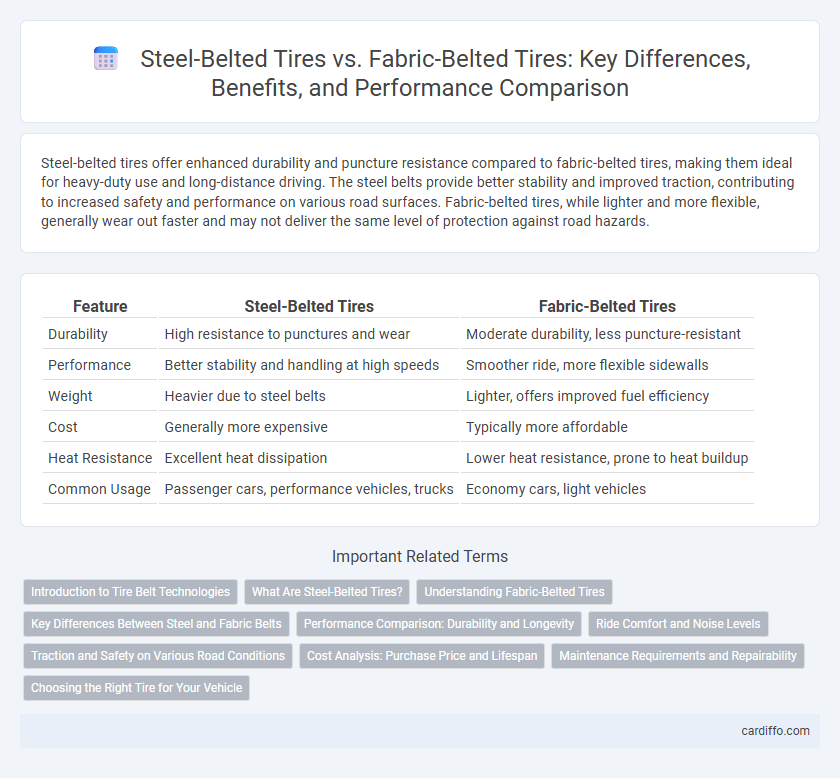Steel-belted tires offer enhanced durability and puncture resistance compared to fabric-belted tires, making them ideal for heavy-duty use and long-distance driving. The steel belts provide better stability and improved traction, contributing to increased safety and performance on various road surfaces. Fabric-belted tires, while lighter and more flexible, generally wear out faster and may not deliver the same level of protection against road hazards.
Table of Comparison
| Feature | Steel-Belted Tires | Fabric-Belted Tires |
|---|---|---|
| Durability | High resistance to punctures and wear | Moderate durability, less puncture-resistant |
| Performance | Better stability and handling at high speeds | Smoother ride, more flexible sidewalls |
| Weight | Heavier due to steel belts | Lighter, offers improved fuel efficiency |
| Cost | Generally more expensive | Typically more affordable |
| Heat Resistance | Excellent heat dissipation | Lower heat resistance, prone to heat buildup |
| Common Usage | Passenger cars, performance vehicles, trucks | Economy cars, light vehicles |
Introduction to Tire Belt Technologies
Steel-belted tires feature layers of steel wires embedded beneath the tread, providing superior strength, puncture resistance, and enhanced durability compared to fabric-belted tires, which use textile materials like polyester or nylon for flexibility and lighter weight. The steel belts improve road grip and help maintain tire shape under high speeds, resulting in better handling and longer tread life. Fabric-belted tires offer a comfortable ride with good shock absorption but typically wear faster and provide less resistance to impact damage than their steel-belted counterparts.
What Are Steel-Belted Tires?
Steel-belted tires feature layers of steel belts embedded beneath the tread to enhance durability, puncture resistance, and tread life. These tires provide improved stability, better traction, and greater strength compared to fabric-belted tires, making them ideal for high-speed driving and heavy loads. The steel belts also help maintain the tire's shape under pressure, ensuring consistent contact with the road for safer handling.
Understanding Fabric-Belted Tires
Fabric-belted tires utilize layers of polyester, nylon, or rayon cords embedded beneath the tread, providing flexibility and a smoother ride compared to steel-belted tires. These tires typically offer improved shock absorption and resistance to road impact, making them suitable for vehicles prioritizing comfort over high-speed performance. Fabric belts are lighter than steel, contributing to reduced rotational mass and enhanced fuel efficiency, but they may exhibit less durability and tread life in demanding driving conditions.
Key Differences Between Steel and Fabric Belts
Steel-belted tires feature layers of steel wires embedded beneath the tread, providing superior strength, puncture resistance, and better tread life compared to fabric-belted tires, which use layers of textile materials such as polyester or nylon. The steel belts offer enhanced stability at high speeds and improved fuel efficiency by reducing rolling resistance, while fabric belts contribute to a softer ride and better flexibility but wear out faster. Steel-belted tires are preferred for heavy-duty and high-performance vehicles, whereas fabric-belted tires are common in passenger cars prioritizing comfort.
Performance Comparison: Durability and Longevity
Steel-belted tires offer superior durability and longevity due to their reinforced steel belts, which provide enhanced resistance to punctures and wear compared to fabric-belted tires. The steel belts maintain tire integrity under high stress, contributing to extended tread life and improved performance on rough surfaces. While fabric-belted tires are lighter and more flexible, their durability and lifespan typically fall short of the robust protection and long-term reliability provided by steel-belted options.
Ride Comfort and Noise Levels
Steel-belted tires provide enhanced stability and durability but tend to generate higher road noise and a firmer ride compared to fabric-belted tires. Fabric-belted tires offer superior ride comfort and quieter performance due to their flexible construction, which absorbs road irregularities more effectively. When prioritizing comfort and noise reduction, fabric belts are generally preferred, whereas steel belts excel in longevity and handling performance.
Traction and Safety on Various Road Conditions
Steel-belted tires offer superior traction and enhanced safety on wet and icy roads due to their rigid steel belts that provide better tread stability and durability. Fabric-belted tires, while lighter and more flexible, tend to perform better on dry roads but may compromise grip and safety on slippery or uneven surfaces. Choosing steel-belted tires ensures improved handling and reduced risk of hydroplaning, especially in challenging road conditions.
Cost Analysis: Purchase Price and Lifespan
Steel-belted tires generally have a higher purchase price compared to fabric-belted tires due to the durable steel belts that enhance performance and safety. Their lifespan is typically longer, often exceeding 50,000 miles, which can offset the initial cost through extended use and reduced replacement frequency. In contrast, fabric-belted tires tend to be cheaper upfront but usually wear out faster, averaging around 30,000 to 40,000 miles, leading to more frequent replacements and potentially higher long-term expenses.
Maintenance Requirements and Repairability
Steel-belted tires require less frequent maintenance due to their durable steel cords, which provide enhanced resistance to punctures and wear compared to fabric-belted tires. Fabric-belted tires, constructed with textile layers, are more prone to damage and typically demand more frequent inspections and repairs, especially in rough driving conditions. Repairing steel-belted tires can be more complex and costly because of the steel belts, whereas fabric-belted tires often allow for easier patching and repair.
Choosing the Right Tire for Your Vehicle
Steel-belted tires offer enhanced durability, better puncture resistance, and improved fuel efficiency compared to fabric-belted tires, making them ideal for heavy-duty vehicles and long-distance driving. Fabric-belted tires provide a smoother ride and greater flexibility, which benefits smaller cars and everyday city driving. Selecting the right tire depends on vehicle type, driving conditions, and performance priorities, ensuring optimal safety and longevity.
Steel-belted tires vs Fabric-belted tires Infographic

 cardiffo.com
cardiffo.com